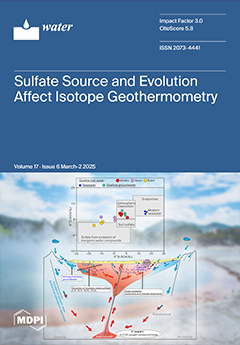This study is the first investigation into the content of heavy metals (ecotoxic) and metalloids in the available water resources of the Papuk Nature Park (Croatia), conducted after the war in Croatia. Analyses of 13 elements, As, B, Ba, Cd, Co, Cr, Cu,
[...] Read more.
This study is the first investigation into the content of heavy metals (ecotoxic) and metalloids in the available water resources of the Papuk Nature Park (Croatia), conducted after the war in Croatia. Analyses of 13 elements, As, B, Ba, Cd, Co, Cr, Cu, Fe, Ni, Pb, Sr, V and Zn, were carried out on 21 water samples from rivers and their tributaries using the ICP-MS method. The concentration of heavy metals and metalloids in the water of the rivers and their tributaries was low, revealing an intact water environment. Depending on the area of sampling, medians (in µgL
−1) were 0.50–4.22 (As), 1.90–141.78 (B), 0.31–60.01 (Ba), 0.16–0.57 (Cd), 0.095–0.62 (Co), 0.18–0.66 (Cr), 1.59–15.89 (Cu), 12.1–1692.2 (Fe), 0.26–8.21 (Ni), 0.017–4.45 (Pb), 0.039–126.09 (Sr), 0.48–2.53 (V), and 3.01–25.95 (Zn). Higher concentrations of Fe (median ranged from 155.42 to 968.20 µgL
−1) were found in the northern part of the Papuk Nature Park and are considered to be of natural origin; therefore, anthropogenic influences are excluded. The watercourses of the Papuk Nature Park are generally characterized as a clean ecosystem. This, in part, can be attributed to the human activism legislation that declared Papuk a Nature Park, and the self-healing potential of nature.
Full article





